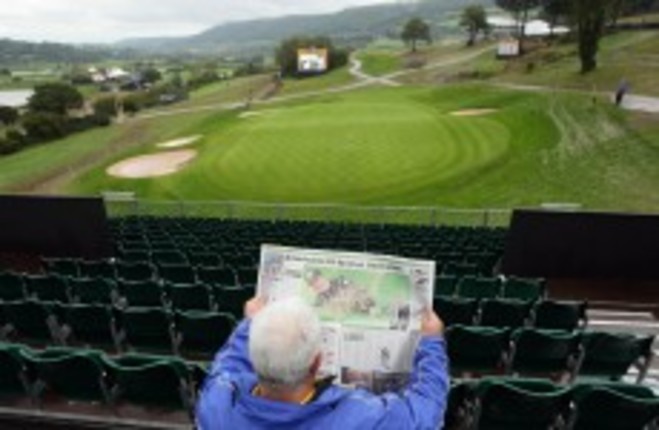1. So Rory McIlroy went for dinner at the White House on Wednesday. To complete his arrival in the sporting stratosphere, golf’s world No 1 was selected among the 1,000 guests who garlanded President Obama’s state reception for the Prime Minister. My sources in in New York’s garment district disclose that he was given a suit fitting from designer Alexander Nash — and one must hope, ardently, he chose not to accessorise the look with those preppy thick-rimmed glasses that he unleashed upon the world at last year’s Sports Personality of the Year bash. Front-row seat at the Miami Heat, a banquet chez Barack at 1600 Pennsylvania Avenue — oh, and the little matter of his 11th top-five finish since August sprinkled in between. You have to like the way this boy rolls.
The American public are quickly falling in love with a young man from Hollywood, County Down. In the Telegraph, Oliver Brown takes a look at Rory McIlroy’s transformation from protégé to idol.
2. Mutombo may be a renowned basketball player and humanitarian. But as a UN Group of Experts report published last December makes clear, he’s not much of a businessman. Mutombo had linked up with Houston-based oil executive Kase Lawal, a respected businessman whom President Barack Obama had appointed to the Federal Trade Commission’s Advisory Committee for Trade Policy and Negotiation. According to the UN document (and as first reported by The Houston Chronicle), the two attempted to purchase what they thought was $30 million worth of gold from dealers in Kenya — only to find out that the gold (most of which was probably counterfeit) was in the possession of a notorious Congolese warlord, who ended up profiting handsomely off of Mutombo and Lawal’s blind enthusiasm and almost total lack of due diligence.Dikembe Mutombo is an eight-time NBA All-Star, so how did he get tied up in the murky world of Congo’s corrupt gold trade? Armen Rosen’s feature in the Atlantic explains all.
3. Jones unfolds himself from the soft leather seat with a big grin and pushes his Gucci sunglasses to the top of his head. He’s wearing essentially what he’s worn since he dropped out of college five years ago: white tee, camo shorts, black leather Converses with the laces untied. He has a freakishly sculpted physique: 6-foot-4 with broad shoulders that taper down to a carved midsection and a narrow waist. The only thing about him that doesn’t look strong is his legs, which seem to have little, if any, muscle. Hence the name Bones. But even this physical quirk is a fighting advantage: Those legs keep opponents at bay with punishing kicks he can deliver from odd, unpredictable angles. Few of the guys he fights get close enough to touch his face.
Jon Jones is a pastor’s son with a gift for violence. Jesse Hyde meets the “sweet and vicious” UFC superstar for Men’s Journal.
4. The ingratitude of the network beggared belief. As Richard and Andy’s publicity material subsequently insisted, they were “the driving force behind Sky Sports’ rise to football supremacy”, becoming “synonymous with the rise of Premiership football throughout the world”. And which of us has not found ourselves in a watering hole in some remote region of the globe, the conversational barrier traversed not by smiling reference to Wayne Rooney, but by excited natives speaking the international language of Keysey and Grayey? Yet back home in our benighted land, these two assets remain currently consigned to radio. Where’s the justice?Are Richard Keys and Andy Gray launching a stealth campaign to work themselves back into the public eye. The Guardian’s Marina Hyde certainly thinks so.
5. The last shot fell at a little past three on a Saturday afternoon in Los Angeles. Rolando Blackman, a willowy 6-foot-6 Kansas State senior from Panama by way of the Bronx, pounded three dribbles to the right baseline and rose quietly off the floor before stroking a jumper that gave the Wildcats a 50-48 lead over Oregon State with two seconds to play in their NCAA tournament game at Pauley Pavilion. Oregon State was ranked No. 2 in the nation after spending much of the regular season at No. 1, and now was almost certain to exit the tournament without winning a game. NBC play-by-play announcer Jay Randolph shouted his call – “A 16-footer from the deep right corner has put the Wildcats on top!” – but his voice is scarcely audible on the game DVD beneath a thunderous explosion of noise. Oregon State missed a long heave at the horn and then came another roar.
On 14 March 1981, three buzzer-beaters were caught live on television and America became hooked on the NCAA college basketball tournament. Tim Layden has the story of the birth of “March Madness” in Sports Illustrated.
6. Lizette Salas had been working toward the highest stage of women’s professional golf since age 7. The daughter of Mexican immigrants, she used golf to become the first in her family to earn a college degree. She had spent much of last year traveling to tournaments on the L.P.G.A. Futures Tour in a truck with her father, sometimes sleeping in rest areas to save money. So with the last full-status tour card on the line in December’s L.P.G.A. qualifying tournament, Salas put her lifelong survival instincts to work. Salas, 22, birdied her final hole in regulation to join a three-hole, nine-woman playoff, then birdied all three of the extra holes to earn a spot on the L.P.G.A. Tour. Standing beside the 18th green when her last birdie putt fell in, her parents cried tears of joy.Making the breakthrough onto the LPGA Tour is no easy task, writes Lisa Mickey as she meets Lizette Salas for the New York Times.

